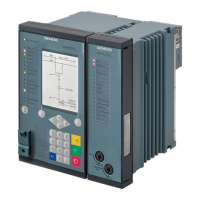EXAMPLE
Overcurrent-protection stage: 110-kV overhead line, 150 mm
2
cross-section
Maximum transmittable power
P
max
= 120 MVA
Correspondingly
I
max
= 630 A
Current transformer = 600 A/5 A
Safety factor = 1.1
Settings in primary and secondary values result in the setting values:
[foocpph1-030311-01.tif, 2, en_US]
The Operate delay to be set is derived from the time-grading schedule that has been prepared for the
system.
2nd stage (high-current stage):
This tripping stage can also be used for current grading. This applies in the case of very long lines with low
source impedance or ahead of high reactances (for example, transformers, shunt reactors). Set the
Threshold parameter to ensure that the stage does not pick up in case of a short circuit at the end of the
line.
Set the Operate delay parameter to 0 or to a low value.
Siemens recommends that the threshold values be determined with a system analysis. The following example
illustrates the principle of grading with a current threshold on a long line.
EXAMPLE
High-current stage: 110-kV overhead line, 150 mm
2
cross-section
s (length) = 60 km
Z
L
/s = 0.46 Ω/km
Ratio of zero-sequence impedance and positive-sequence impedance of the line: Z
L0
/Z
L1
= 4
Short-circuit power at the beginning of the line:
S
sc
' = 2.5 GVA
Ratio of zero-sequence impedance and positive-sequence impedance of the source impedance at the
beginning of the line: Z
P0
/Z
P1
= 2
Current transformer = 600 A/5 A
Resulting in the following values for the line impedance Z
L
and the source impedance Z
P
:
[fo_OCP002_030311, 1, en_US]
[fo_OCP003_030311, 1, en_US]
The 3-phase short-circuit current at the end of the line is I
sc end
:
Protection and Automation Functions
7.4 Overcurrent Protection, Phases
SIPROTEC 5, High-Voltage Bay Controller, Manual 607
C53000-G5040-C015-9, Edition 11.2017

